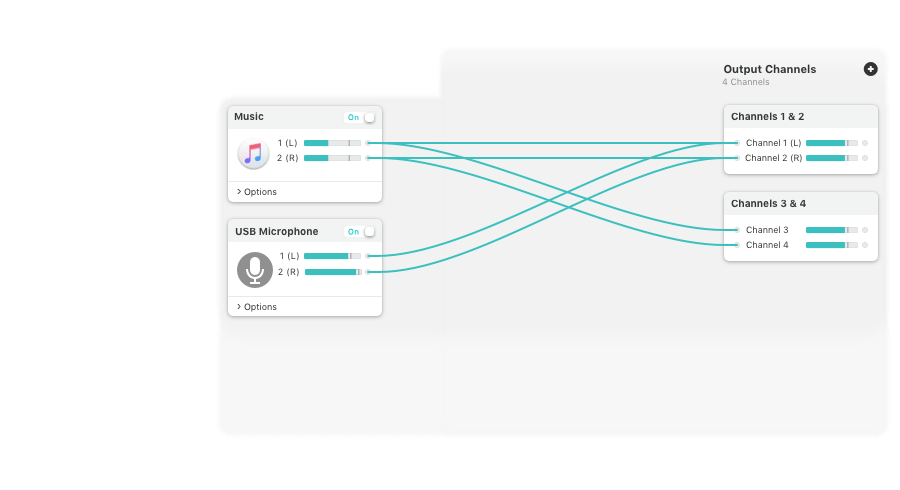Loopback 1 1 8 – Route Audio Between Applications


After you move the loopback plug, you can clarify this if you first clear the controller counters with the clear controller t1 0/0/0 command, then see if line and path code violations increment. Use the procedure described in IP Interface. There is no difference between loopback testing for a T1 or an E1. Telco-Assisted Loopback. VB-CABLE is a virtual audio device working as virtual audio cable. All audio coming in the CABLE input is simply forwarded to the CABLE output. Download and Install VB-CABLE Driver Now! VBCABLEDriverPack43.zip (1.09 MB - OCT 2015 / XP to WIN10 32/64 bits) INSTALLATION: Extract all files and Run Setup Program in administrator mode.
Loopback for Mac is an audio routing software for Mac which can pass audio between applications on your Mac. Loopback can combine audio from both application sources and audio input devices, then make it available anywhere on your Mac. LoopBack is a highly-extensible, open-source Node. Figure 1 illustrates how an app connects to a receiver device through the media router framework. Overview of how media route provider classes provide communication from a media app to a receiver device. Note: If you want your app to support Google Cast devices, you should use the Cast SDK and build your.
Overview
LoopBack is built on Express and implements Express’ routing system. However, basic Express routing is limited only to a small portion of the functionality of LoopBack.A large part of LoopBack’s features are implemented using its more detailed extension to the routing system.Understanding this system will help you understand LoopBack better and develop better LoopBack apps.
Summary of Express routing
For those not familiar with routing in Express, here are some key points:
Photomatix pro 6 24. Routing refers to the rules for capturing requests to the server, and the subsequent passing through and handling of requests through a chain of middleware functions.
A middleware function accepts three objects, the request object (req),the response object (res),and the next middleware in the chain (next); in that order.
You load middleware either using app.use() or by assigning it as the callback function of aroute definition.
Multiple middleware can be matched to handle the requests to a route,these matched middleware make up the middleware chain for the request.The request will pass through each middleware in the order they were loaded, unless one of the middleware in the chain terminates the propagation.
Any middleware in the chain may terminate the request propagation by sending a response back to the client.
A middleware can send the response to the request using one of the response methods in the response objector pass on the request to the next middleware by calling next().
If a middleware sends the server response, conventionally the request does not propagate further in the middleware chain.Any call to next() will likely result in an error.
A middleware function can also take four arguments. In this case, it is an error handling middleware.The parameters to the function in their order are: the error object (err),the request object (req), the response object (res),and the next middleware in the chain (next).
For more details about routing in Express, see http://expressjs.com/guide/routing.html.
LoopBack routing
LoopBack implements the middleware pattern of request routing, therefore the concept of middleware and routing is the same as in Express.However, the Express aspect of routing is contained within the modified middleware chain generated by LoopBack.The extended routing details in LoopBack is best understood by understanding the LoopBack middleware chain.

LoopBack middleware chain
The LoopBack middleware chain is composed of middleware added to the chain in the following order, and the request passes through them in the given order.
Note:
Except 14, 15, and 16, the listed items refer to LoopBack middleware phases.
- initial:before
- initial
- initial:after
- session:before
- session
- session:after
- auth:before
- auth
- auth:after
- parse:before
- parse
- parse:after
- routes:before
- routes
- routes:after
- files:before
- files
- files:after
- final:before
- final
- final:after
A middleware loaded earlier in the chain gets the prior opportunity to handle the request.If it happens to send a response or fail to call next(), the request will terminate at it, and not propagate any further.
As evident from the list above, LoopBack takes control of the loading order of the middleware in the app, and prioritizes its relevantmiddleware over those loaded using Express’ interface app.use(), components, or boot scripts.
Note:
If you add middleware on the route or route:after phase, it will not execute after the route is matched.Instead, it will be ignored because the route was already matched.
The middleware to be loaded during the middleware phases are configured in the middleware.json file of the app.The order of the phases in the file are semantic, and cannot be listed randomly.
LoopBack also supports custom phases.Custom phases can be defined in any position of the middleware chain, and may be used to prioritize over LoopBack’s built-in middleware phases. Memorytamer 1 5 1 – automatic memory freeing applying.
Loading middleware
LoopBack middleware are declaratively loaded using the middleware.json file,or imperatively using the app.middleware() method.
Express middleware can be loaded in the server.js file using app.use()or a route definition.
Loopback Audio Mac
Folder factory 5 7 5 0. LoopBack components can load middleware using the reference to the LoopBack application instance.
Loopback 1 1 8 – Route Audio Between Applications Pdf
Boot scripts can load middleware using the reference to the LoopBack application instance.
Audio Loopback Driver
Thanks,
Dave

Loopback 1 1 8 – Route Audio Between Applications
UNDER MAINTENANCE